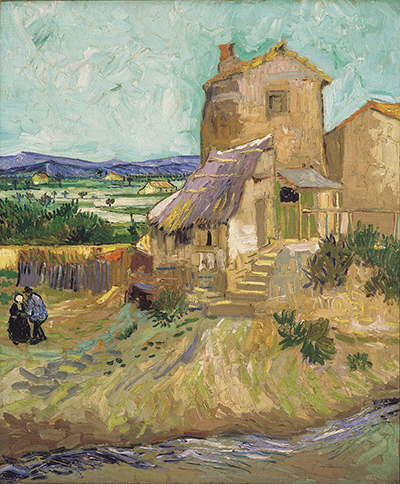Van Gogh created the oil painting known as The Old Mill, La maison de La Crau in French, during September 1888. This work was undertaken during a particularly productive period for Van Gogh.
In February 1888, after spending two years in Paris, Van Gogh had become tired with the hustle and bustle and cold weather of northern France. He missed the sunshine and colours of southern France which led him to move from the French capital to Arles in the south of France.
Van Gogh Productivity in Arles
The Old Mill was one of more than two hundred paintings completed by Van Gogh, over a period of fifteen months, during his time in Arles. The subject matter of the paintings created during this time included both portraits and landscapes.
Style of Painting for The Old Mill
The canvas of the Old Mill features thickly applied oils displaying a wide range of brush strokes and colours which are considered to reflect the artist's feelings regarding the image rather than being used as a direct representation of the subject of the painting. The artist was inspired to use short, sharp strokes of the brush when painting foliage while using longer strokes to create other images. The painting of the sky and clouds are considered to have been inspired by the foaming sea and are depicted using smooth and curving strokes.
Critics of the Van Gogh Painting Style
Some critics suggested that Van Gogh worked too quickly when painting. However, the careful brushstrokes clearly seen in this painting suggest that the artist had a clear vision of what he wished to portray before he started to put the paint on the canvas. It is claimed that Van Gogh wrote about the process that went into each painting, a process that was at length and in advance. As a consequence, the artist was able to work rapidly when the time came to apply the pigment to the canvas. It is reported that Van Gogh's response to such criticism was, "When anyone says that it is done too quickly, then they have looked at it too quickly."
The subject of the painting was known locally in Arles as tabatière or Jonque. The artist undertook the work after he had moved into his Yellow House studio. In October 1888, Van Gogh was joined in the Yellow House by Paul Gauguin. Upon completion, Van Gogh sent the painting of the Old Mill to Emile Bernard in October 1888. The canvas was traded by Bernard to Ernest de Chamaillard who retained it until 1927. The canvas was then purchased by Anson Goodyear, a member of the Goodyear Tyre family. The painting was acquired by the Albright–Knox Art Gallery of Buffalo, New York, USA in 1966. The painting remains on display at the Albright-Knox gallery today.




